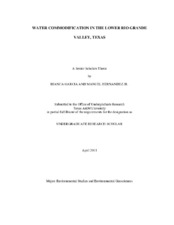| dc.description.abstract | The lower Rio Grande Valley of Texas is one of the poorest regions with the largest population lacking suitable water supply in the entire United States. The region is characterized by low-income, rural and peri-urban communities called colonias.Nearly half of the 238,000 colonia residents face known infrastructure deficiencies in water, sanitation, or both, while nearly one-fifth have unknown water and sanitation status. The commodification of water quality through water vendors has expanded rapidly throughout South Texas, questioning their motives for positioning their businesses in certain locations. We will explore the relationship between poverty and water vending through a spatial analysis using a Geographic Information System. Our analysis revealed significant correlations between demographic variables and water vending unit locations. The spatial distribution was strong in relation to colonia locations, confirming the belief that water companies placed water vending units for the region’s poor communities. | en |


